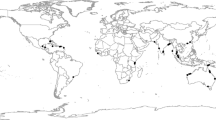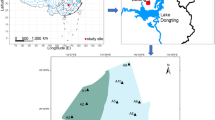Abstract
Purpose
Extensive amounts of untreated sewage are discharged in creeks lined by mangrove forests. This is a common occurrence in peri-urban coastal areas of the developing world. There is much evidence to suggest that mangroves filter discharged wastewater and prevent coastal pollution. The Mikindani mangrove system, Kenya has been exposed to sewage for more than a decade. The study seeks to investigate the ability of the Mikindani mangrove system to deal with the sewage carbon load.
Materials and methods
The ability of the mangrove system to phytoremediate sewage was investigated using anaerobic incubation experiments of sediments collected at several locations along the length of the creek at the study site. Carbon dioxide production was used as a proxy to measure the rate of organic matter degradation.
Results and discussion
The carbon dioxide production for the 0–1-cm sediment segment at site MKR 1 (the sewage input site) increased twofold after 8 days, implying that the natural system does not get enough time to stabilize since it is dosed continuously every tidal cycle. In situ CO2 efflux at site MKR 3 (~6 km from the sewage input site) was about three times the ∑CO2 production obtained after incubation for 8 days (anaerobic), which indicates that the easily degradable sediment organic carbon pool had degraded by about 67 % after 8 days. This suggests that this is sufficient time for the Rhizophora mangrove sediment system under anaerobic natural conditions to naturally degrade the system's sediment organic matter.
Conclusions
The Mikindani mangrove system effectively spreads the discharged sewage over a distance of ~3 km. This effectively spreads the impact allowing the system to phytoremediate the artificially added organic matter.





Similar content being viewed by others
References
Aller RC (1994) The sedimentary Mn cycle in Long Island Sound: its role as intermediate oxidant and the influence of bioturbation, O2 and CO2 flux on diagenetic reaction balances. J Mar Res 52:259–295
Alongi DM, Tirendi F, Dixon P, Trott LA, Brunskill GJ (1999) Mineralization of organic matter in intertidal sediments of a tropical semi-enclosed delta. Estuary Costl Shelf Sci 48:451–467
Alongi DM, Tirendi F, Clough BF (2000) Below-ground decomposition of organic matter in forests of the mangroves Rhizophora stylosa and Avicennia marina along the arid coast of Western Australia. Aq Bot 68:97–122
Alongi DM, Wattayakorn G, Pfitzner J, Tirendi F, Zagorskis I, Brunskill J, Davidson A, Clough BF (2001) Organic carbon accumulation and metabolic pathways in sediments of mangrove forests in southern Thailand. Mar Geol 179:85–103
Andersen F, Kristensen E (1988) Oxygen microgradients in the rhizosphere of the mangrove Avicennia marina (Forsk.) Vierh. Mar Ecol: Prog Ser 44:201–204
Andren O, Schnurer J (1985) Barley straw decomposition with varied levels of microbial grazing by Folsomia fimetaria (L.) (Collembola isotomidae). Oecologia 68:57–62
Bickford GP (1996) The effects of sewage organic matter on biogeochemical processes within mid-shelf sediments offshore Sydney, Australia. Mar Poll Bull 33:168–181
Blakemore LC, Searle PL, Daly BK (1987) Methods for chemical analysis of soils. New Zealand Soil Bureau Scientific Report No. 80
Canfield DE, Kristensen E, Thamdrup B (2005) Aquatic geomicrobiology. Elsevier, Amsterdam, 640 p
Chiu CY, Hsiu FS, Chen SS, Chou CH (1995) Reduced toxicity of CU and Zn to mangrove seedlings in saline environments. Bot Bul Acad Sinca 36:19–24
Corredor JE, Morell IM (1994) Nitrate depuration of secondary sewage effluents in mangrove sediments. Estuaries 17:295–300
Feller IC (1995) Effects of nutrient enrichment on growth and herbivory of dwarf red mangrove (Rhizophora mangle). Ecol Monogr 65:477–505
Feller IC, Whigham DF, McKee KL, Lovelock CE (2003) Nitrogen limitation of growth and nutrient dynamics in a disturbed mangrove forest, Indian River Lagoon, Florida. Oecologia 134:405–414
Froelich PN, Klinkhammer GP, Bender ML, Luedtke ML, Heath GR, Cullen D, Dauphin P, Hammond D, Hartman B, Maynard V (1979) Early oxidation of organic matter in pelagic sediments of the eastern equatorial Atlantic: suboxic diagenesis. Geochim Cosmochim Avta 43:1075–1090
Furukawa K, Wolanski E, Mueller H (1997) Currents and sediment transport in mangrove forests. Estuar Coast Shelf Sci 44:301–310
Goulden ML, Munger JW, Fan SM, Daube BC, Wofsy SC (1996) Exchange of carbon dioxide by a deciduous forest: response of interannual climate variability. Science 271:1576–1578
Hanson PJ, Edwards NT, Garten CT, Andrews JA (2000) Separating root and soil microbial contributions to soil respiration: review of methods and observations. Biogeochemistry 48:115–146
Holmer M, Andersen F, Holmboe N, Kristensen E, Thongtham N (1999) Transformation and exchange processes in the Bangrong mangrove forest-seagrass bed system, Thailand. Seasonal and spatial variations in benthic metabolism and sulfur biogeochemistry. Aquat Microb Ecol 20:203–212
Jenkinson DS, Fox RH, Rayner JH (1985) Interactions between fertilizer nitrogen and soil nitrogen-the so-called ‘priming’ effect. J Soil Sci 36:425–444
Ke X, Winter K, Filser J (2005) Effects of soil mesofauna and farming management and decomposition of clover litter: a microcosm experiment. Soil Bio Biochem 37:731–738
Kitheka JU, Ongwenyi GS, Mavuti KM (2002) Dynamics of suspended sediment exchange and transport in a degraded mangrove creek in Kenya. Ambio 31:580–587
Koch MS, Snedaker SC (1997) Factors influencing Rhizophora mangle L. seedling development in Everglades carbonate soils. Aquat Bot 59:87–98
Konate S, Le Roux X, Verdier B, Lepage M (2003) Effect of underground fungus-growing termites on carbon dioxide emission at the point-and-landscape-scales in an African savanna. Funct Ecol 17:305–314
Kostka JE, Luther GW (1994) Partitioning and speciation of solid phase iron in saltmarsh sediments. Geochim Cosmochim Acta 58:1701–1710
Krishnan KP, Loka Bharathi PA (2009) Organic carbon and iron modulate nitrification rates in mangrove swamps of Goa, south west coast of India. Estuar Coast Shelf Sci 84:419–426
Krishnan KP, Fernandes SO, Chandan GS, Loka Bharathi PA (2007) Bacterial contribution to mitigation of iron and manganese in mangrove sediments. Mar Pollut Bull 54:1427–1433
Kristensen E (2000) Organic matter diagenesis at the oxic/anoxic interface in coastal marine sediments, with emphasis on the role of burrowing animals. Hydrobiologia 426:1–24
Kristensen E, Devol AH, Ahmed SI, Saleem M (1992) Preliminary study of benthic metabolism and sulfate reduction in a mangrove swamp of the Indus delta, Pakistan. Mar Ecol: Prog Ser 90:287–297
Kristensen E, Holmer M, Banta GT, Jensen MH, Hansen K (1995) Carbon, nitrogen and sulfur cycling in sediments of the Ao Nam Bor mangrove forest, Phuket, Thailand: a review. Phuket Mar boil Cent Res Bull 60:37–64
Kristensen E, Andersen F, Holmboe N, Holmer M, Thongtham N (2000) Carbon and nitrogen mineralization in sediments of the Bangrong mangrove area, Phuket, Thailand. Mar Ecol: Prog Ser 22:199–213
Kristensen E, Bouillon S, Dittmar T, Marchand C (2008) Organic carbon dynamics in mangrove ecosystems. Aquat Bot 89:201–219
Kuzyakov Y (2006) Sources of CO2 efflux from soil and review of partitioning methods. Soil Bio Biochem 38:425–448
Kuzyakov Y, Domanski G (2000) Carbon input by plants into the soil. Rev J Plant Nutr Soil Sci 163:421–431
Laima MJC (1994) Is KCl a reliable extractant of 15NH4+ added to coastal marine sediments? Biogeochemistry 27:83–95
Longdoz B, Yernaux M, Aubinet M (2000) Soil CO2 efflux measurements in a mixed forest: impact of chamber distances, spatial variability and seasonal evolution. Global Change Bio 6:907–917
Lovley DR, Phillips EJP (1987) Rapid assay for microbially reducible ferric iron in aquatic sediments. Appl Environ Microbiol 53:1536–1540
Lynch JC, Meriwether JR, McKee BA, Vera-Herrera F, Twilley RR (1989) Resent accretion in mangrove ecosystems based on 137Cs and 210Pb. Estuaries 12:284–299
MacFarlane GR, Burchett MD (2002) Toxicity, growth, and accumulation relationships of copper, lead and zinc in the grey mangrove Avicennia marina (Forsk.) Vierh. Mar Env Res 54:65–84
Munga D, Yobe, Owili, Mwaguni (1994) Assessment of land based sources of marine pollution along the Kenya coast. Draft report prepared for FAO, KMFRI, Mombasa, Kenya
Nielsen OI, Kristensen E, Macintosh DI (2003) Impact of fiddler crabs (Uca spp) on rates and pathways of benthic mineralization in deposited shrimp pond waste. Exp Mar Biol Ecol 289:59–81
Norconsult AS (1977) Mombasa water pollution and waste disposal study: report to the Ministry of Local Government (Kenya), marine investigations, 6. Nairobi, Kenya, pp 104
Okemwa E (1990) A study of the pelagic copepods in a tropical marine creek Tudor, Mombasa, Kenya, with a special reference to their community structure, biomass and productivity. PhD Thesis, Free University, Brussels, Belgium
Ong JE (1993) Mangroves—a carbon source and sink. Chemosphere 27:1097–1107
Parsons TR, Maita Y, Lalli CM (1984) A manual of chemical and biological methods for seawater analysis. Pergamon Press, Oxford, UK, 173 pp
Reef R, Feller IC, Lovelock CE (2010) Nutrition of mangroves. Tree Physiology 30:1148–1160
Rorbertson AI, Alongi DM, Boto KG (1992) Food chains and carbon fluxes. In: Robertson AI, Alongi DM (eds) Tropical mangrove ecosystems. American Geophysical Union, Washington, DC, USA, pp 293–326
Sokal RR, Rohlf FJ (1995) Biometry, 3rd edn. Freeman, New York
Tam NFY, Wong YS (1999) Mangrove soils in removing pollutants from municipal wastewater of different salinities. J Environ Qual 28:556–564
Twilley RR, Chen RH, Hargis T (1992) Carbon sinks in mangroves and their implications to carbon budget of tropical coastal ecosystems. Water, Air, Soil Pollut 64:265–288
Victor S, Golbuu Y, Wolanski E, Richmond RH (2004) Fine sediment trapping in two mangrove-fringed estuaries exposed to contrasting land-use intensity, Palau, Micronesia. Wetl Ecol Manag 12:277–283
Walsh GE, Ainsworth KA, Rigby R (1979) Resistance of the red mangrove (Rhizophora mangle (L)) seedlings to Pb, cadmium and mercury. Biotropica 11:22–27
Wolanski E (1995) Transport of sediment in mangrove swamps. Hydrobiologia 295:31–42
Wong YS, Tam NFY, Lan CY (1997) Mangrove wetlands as wastewater treatment facility: a field trial. Hydrobiologia 352:49–59
Woodroffe R (1992) Mangrove sediments and geomorphology. In: Robertson AI, Alongi DM (eds) Tropical mangrove ecosystems. American Geophysical Union, Washington, DC, pp 7–41
Ye Y, Tam NFY, Wong YS (2001) Livestock wastewater treatment by a mangrove pot-cultivation system and the effect of salinity on the nutrient removal efficiency. Mar Poll Bull 42:513–521
Acknowledgments
The authors wish to thank PUMPSEA (Peri-urban mangrove forests as filters and potential phytoremediators of domestic sewage in East Africa) for funding the study.
Author information
Authors and Affiliations
Corresponding author
Additional information
Responsible editor: Fred Ellery
Rights and permissions
About this article
Cite this article
Kamau, J.N., Ngila, J.C., Kirui, B. et al. Spatial variability of the rate of organic carbon mineralization in a sewage-impacted mangrove forest, Mikindani, Kenya. J Soils Sediments 15, 2466–2475 (2015). https://doi.org/10.1007/s11368-015-1271-7
Received:
Accepted:
Published:
Issue Date:
DOI: https://doi.org/10.1007/s11368-015-1271-7




